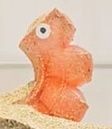| Next On The Menu - Edible Robots |
| Written by Lucy Black | |||
| Friday, 21 November 2025 | |||
|
Researchers from the Laboratory of Intelligent Systems at the Ecole Polytechnique Federale de Lausanne in Switzerland have demonstrated robotic batteries and actuators that can be ingested without causing problems. The problem with traditional robots is that even those that claim to be ingestible have excluded the motor and battery because of their toxic properties. If you're wondering why you'd want to create an edible robot, the researchers say one use is the distribution of consumable bait infused with vaccines for controlling the spread of contagious diseases among wild animals. Studies have shown that carnivores and certain omnivores, such as wild boars, prefer to consume live, moving prey. Doing this with actual live prey in open areas is tricky, because other non-target species are attracted. The vision is that the fully edible system could power animated robotic prey items that can selectively attract the correct targets.
The robot needs to be able to move to attract the target animal, which means having some motor and battery to power it. The prototype robot has an edible pneumatic battery that uses the fact that food-grade citric acid mixes with sodium bicarbonate powder to produce a steady release of carbon dioxide (CO2) gas. In the test, the two materials are kept apart in separate chambers made of gelatin and wax with a membrane between the two. When you want to activate your device, you apply pressure. In the experiment this is achieved using a foot pump that is activated when one of the wild boar steps onto the top cover of the pneumatic battery with sufficient foot pressure. This punctures the membrane, letting the liquid citric acid drop onto the bicarbonate of soda, so beginning the generation of CO2 gas. Gelatin, glycerol, beeswax and carnauba wax were used to fabricate the pneumatic actuator and valves. What's clever about the design is that to make the device look as though its continuing to move (to attract the target prey), the actuator needs to have multiple releases of gas. This is achieved using an ingestible valve. This uses a technique known as snap-buckling. Snap-buckling describes the way a structure moves between two stable states after a critical load is applied. At rest, the shape will stay in one shape, but if you put it under sufficient pressure, it will snap open, then close again once the pressure is released. The demonstration robot opens and closes four times a minute for a couple of minutes before the battery is exhausted. This research was funded by the European Union's RoboFood project, and the team is also working on other edible robots.
More InformationResearch Paper On Edible Robot Related ArticlesRobotic Gut Spider For Exploring Digestive Tract
To be informed about new articles on I Programmer, sign up for our weekly newsletter, subscribe to the RSS feed and follow us on Twitter, Facebook or Linkedin.
Comments
or email your comment to: comments@i-programmer.info |
|||
| Last Updated ( Friday, 21 November 2025 ) |



